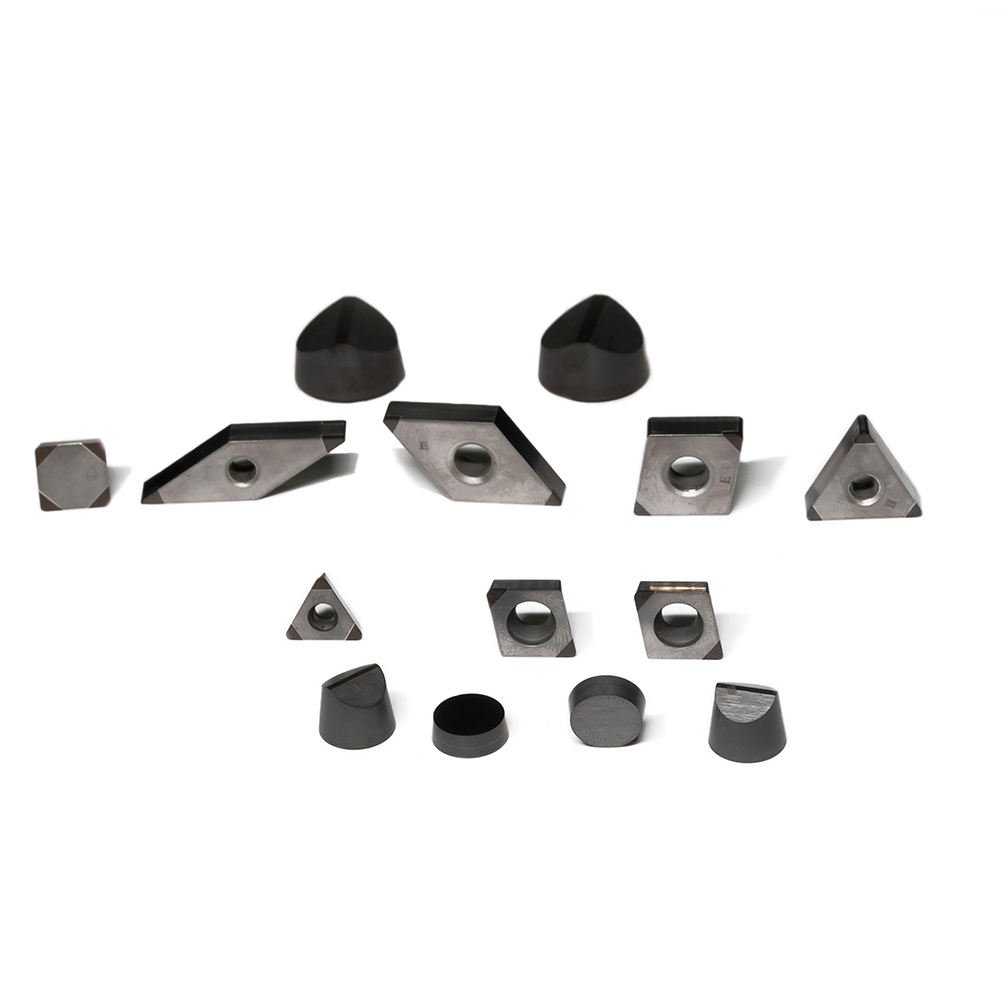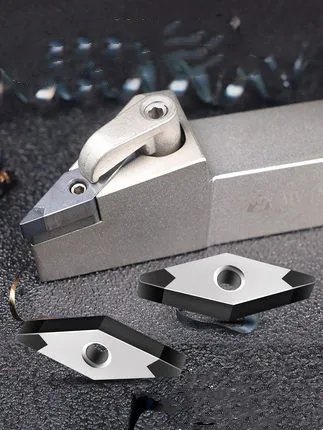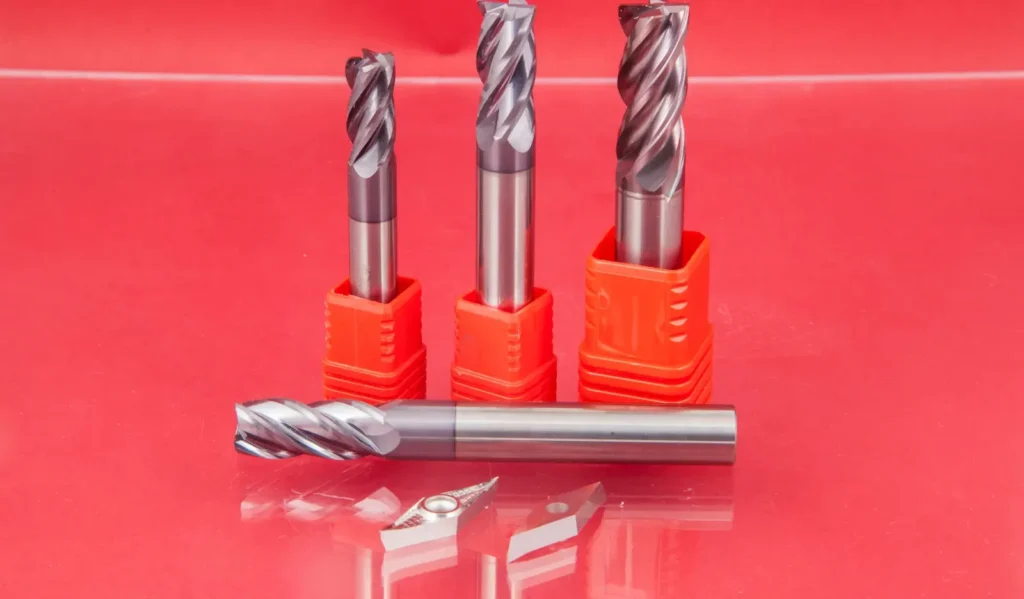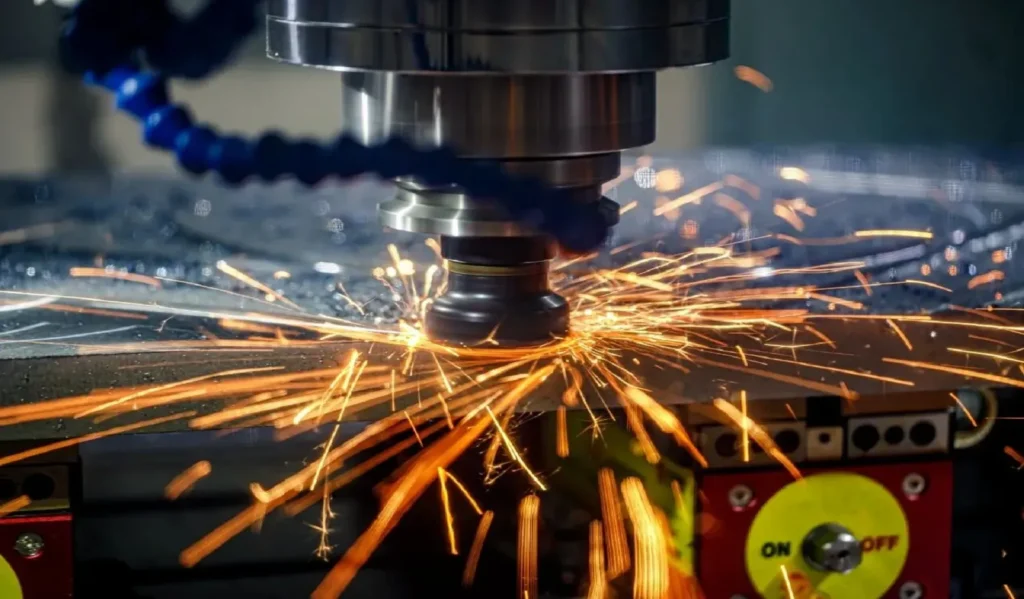“Solid CBN inserts for hard turning with high wear resistance, good thermal stability and excellent surface quality. When machining materials such as hardened steel, cast iron and high-temperature alloys, the use of solid CBN inserts can improve machining efficiency and accuracy while extending tool life. This article will present the advantages, application scenarios and selection methods of solid CBN inserts to help the reader better understand the use of solid CBN inserts in hard turning.”



| Recommended material processing parameters for solid CBN inserts | |||||
| Workpiece material | Hardness | Cutting speed(m/min) | Feedrate (mm/rev) | Cutting speed (mm) | |
| Grey cast iron | HB170~230 | 500~1500 | 0.1~0.4 | 0.1~1.5 | |
| Ductile cast iron | HB240~300 | 200~400 | 0.1~0.4 | 0.1~1.5 | |
| Alloy cast iron | HB240~300 | 150~300 | 0.05~0.4 | 0.1~1.5 | |
| Iron-based alloys | HRC45~50 | 50~150 | 0.05~0.4 | 0.05~0.5 | |
| Hardened steel | HRC45~65 | 80~200 | 0.05~0.2 | 0.05~0.2 | |
| Heat resistant alloys | / | 50~200 | 0.05~0.2 | 0.05~0.2 | |
The importance of using the right cutting tools for hard materials
Using the correct cutting tools for hard materials is essential for machining quality and efficiency. Hard materials, such as hardened steels, cast iron and high-temperature alloys, are often highly hard and wear-resistant, which makes them difficult to machine. If unsuitable cutting tools are used, this can lead to reduced machining quality, increased cutting forces and shorter cutting tool life. Conversely, the use of cutting tools specifically designed for hard material machining, such as solid CBN inserts, can significantly improve machining efficiency and accuracy, while extending the life of the cutting tool.
Below is a brief list of the advantages and disadvantages of the various types of tools available to cope with various hard materials.
| Type of Cutting Tool | Materials to Be Machined | Advantages | Disadvantages |
| Solid CBN Inserts | Hardened Steel, High-Temperature Alloys, Ceramics, etc. | High hardness, wear resistance, and excellent heat resistance; Suitable for high-speed cutting and dry cutting; High precision and good surface quality. | Expensive; Brittle, prone to chipping or cracking. |
| Cemented Carbide Inserts | Cast Iron, Aluminum Alloys, Titanium Alloys, Stainless Steel, etc. | Good toughness, wear resistance, and corrosion resistance; Suitable for roughing and finishing relatively inexpensive. | Unsuitable for high-speed cutting, prone to thermal cracking; Difficult to machine superhard materials. |
| Ceramic Inserts | High-Temperature Alloys, Ceramics, Glass, etc. | High hardness, wear resistance, heat resistance, and chemical stability; Suitable for high-temperature cutting and dry cutting; High precision and good surface quality. | Brittle, prone to chipping or cracking, unsuitable for intermittent cutting. |
| PCD Inserts | Cemented Carbide, Fiber-Reinforced Plastics, Composite Materials, etc. | High hardness, wear resistance, and excellent thermal conductivity; Suitable for high-speed cutting and dry cutting; Relatively inexpensive. | Prone to chipping or cracking; Unsuitable for machining non-metallic materials. |
| Diamond Inserts | Ceramics, Glass, Semiconductor Materials, etc. | High hardness, wear resistance, and chemical stability; Suitable for ultra-precision cutting and polishing; High machining efficiency. | Expensive; Brittle, prone to chipping or cracking. |
| High-Speed Steel Cutting Tools | Cast Iron, Stainless Steel, Aluminum Alloys, etc. | Good toughness, wear resistance, and thermal conductivity; Suitable for general cutting. | Unsuitable for high-speed cutting; Prone to wear and deformation. |
Note: The advantages and disadvantages listed in the table are for reference only. In actual applications, multiple factors such as processing conditions, cutting parameters, and workpiece shapes need to be considered comprehensively.
What is a solid CBN insert?

CBN is an abbreviation for “cubic boron nitride”, which is a super hard material second only to diamond in the world in terms of hardness. CBN has high hardness, high thermal stability, high chemical stability, high thermal conductivity and other excellent properties, and is widely used in cutting and processing fields, such as automotive, aviation, aerospace, molds and so on.
Advantages of solid CBN inserts:
1. High hardness CBN is 90% harder than diamond and more than 5 times harder than other tool materials.
2. High thermal stability CBN remains stable in high-temperature environments and will not soften or deform.
3. High chemical stability CBN has good corrosion and chemical resistance.
4. High thermal conductivity CBN has more than 4 times the thermal conductivity of steel and can effectively exclude the heat generated during machining.
Applications of solid CBN inserts:
1. The automotive industry for machining automotive engine blocks, cylinder heads, crankshafts, etc.
2. The aerospace industry is used to process aero-engine blades, turbine blades, etc.
3. The mould industry for processing plastic moulds, die-casting moulds, etc.
4. Machining for the efficient processing of various metal materials.
Types of CBN cutting:
CBN tools are available in two main cutting types single-edge and multi-edge.
1. Single-edge CBN tools are suitable for machining hard materials such as alloy steel, stainless steel, high-speed steel, etc.
2. Multi-edge CBN tools are suitable for machining large quantities of workpieces, such as cast iron, copper, aluminum etc. Multi-edged CBN tools are highly efficient in machining, but the cutting quality is relatively poor.
What are the main high-hardness materials that solid CBN inserts are suitable for machining?
- Hardened steel: such as high-speed steel, die steel, and tool steel.
- Cast iron: such as gray cast iron, ductile iron, and white cast iron.
- High-temperature alloys: such as titanium alloys, nickel-based alloys, and chromium-molybdenum alloys.
- Hard alloys: such as tungsten cobalt alloys and tungsten molybdenum cobalt alloys.
- Ceramic materials: such as alumina, silicon nitride, and zirconia.
Solid CBN inserts are able to perform well in the machining of these materials due to their extremely high hardness and wear resistance, and their ability to maintain good stability and longevity in high-temperature and high-pressure machining environments. However, due to the high price of solid CBN inserts, they are generally only used for demanding machining tasks.
Examples of industries where solid CBN inserts are commonly used:
Manufacturing industry: Solid CBN inserts are widely used in the manufacturing industry for precision machining and mold processing, such as automotive parts processing, engine parts processing, aero-engine parts processing, precision mold processing, etc.

Aerospace industry: Solid CBN inserts are also widely used in the aerospace industry, mainly for machining parts made of high-temperature alloys, titanium alloys and other materials.

Electronics industry: solid CBN inserts can also be used for processing semiconductor materials and optical glass and other precision materials, such as processing LED chips, optical lenses, etc.

Energy industry: Solid CBN inserts are also used in the energy industry, mainly for machining components such as oil extraction equipment and drilling tools.

A few key points for maintaining solid CBN inserts:
a. Cutting parameter setting: The cutting parameters for solid CBN inserts need to be set according to the hardness, shape and size of the material being machined to ensure the best cutting results and life. Generally speaking, the cutting speed of CBN inserts should be between 200-500m/min and the feed rate should be between 0.05-0.2mm/r.
b. Coolant selection and use: The machining of solid CBN inserts requires the use of an appropriate coolant to reduce cutting temperatures and friction and to reduce thermal damage and tool wear. Generally, either a water-soluble cutting fluid containing lubricants and rust inhibitors or an oil-based cutting fluid can be used.
c. Tool installation and adjustment: Installation of solid CBN inserts requires attention to the orientation and position of the tool to ensure the correct cutting angle and cutting direction of the insert. The tool clamping force and tool height also need to be adjusted to ensure the stability and cutting accuracy of the tool.
d. Tool care and maintenance: In the process of using solid CBN inserts, the tool needs to be checked and cleaned regularly to ensure that the tool surface is clean and free from scratches. In addition, care needs to be taken to avoid collisions and excessive wear on the tool to prolong its life.
e. Proper storage and protection: Solid CBN inserts need to be stored in a dry, clean and dust-free environment to avoid corrosion and contamination of the tool surface. Attention should also be paid to protecting the tool from moisture and shock to avoid damage or deformation
Here are some popular problems maybe help you.
-
What is the production process of solid CBN inserts?
Solid CBN inserts are a high hardness, high wear resistance cutting tool made from CBN (cubic boron nitride) particles and metal powder sintered at high temperature and pressure.
-
What is the application range of solid CBN inserts?
Solid CBN inserts are suitable for machining high hardness, high thermal stability and high wear resistance materials such as steel, cast iron, alloys etc.
-
What are the advantages of solid CBN inserts compared to carbide inserts?
Solid CBN inserts have a higher hardness, better thermal stability and longer life than carbide inserts. Also, solid CBN inserts offer better cutting efficiency and surface quality.
-
What is the maintenance method for solid CBN inserts?
Maintenance of solid CBN inserts requires attention to keep the tool surface clean and dry to avoid collisions and damage. Also, the tool needs to be inspected and maintained regularly to prolong its life.
-
How much do solid CBN inserts cost?
Solid CBN inserts are relatively expensive, typically several times more than carbide inserts or even more. However, solid CBN inserts have a longer service life and can reduce the frequency and cost of tool changes, while improving machining efficiency and quality, reducing costs and increasing productivity.
-
What is the structure of a solid CBN insert?
Solid CBN inserts generally consist of CBN particles and a metal matrix, and are available in single-edge, multi-edge and inlay configurations.
-
How do I choose the coolant for solid CBN inserts?
The coolant for solid CBN inserts needs to be selected to suit the material being machined and the cutting conditions, usually a water soluble cutting fluid or a pure oil cutting fluid.
-
What are the tool geometries for solid CBN inserts?
Solid CBN inserts are available in rectangular, round, triangular, diamond and trapezoidal geometries, which can be selected according to specific machining requirements.
-
What are the cutting forces and surface quality of solid CBN inserts?
The cutting forces of solid CBN inserts are generally lower than those of carbide inserts, reducing machining loads and losses. Also, the surface quality of solid CBN inserts is better, which can improve machining efficiency and product quality.


